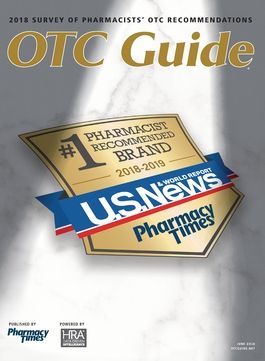Publication
Article
OTC Guide
More Oral Health Care Is Needed for Elderly Adults
Author(s):
A rapidly growing elderly population needs more access to oral health care services, according to a recent report.
But progress is being made in some areas to better care for aging teeth.1
The report A State of Decay, Vol. IV is the latest in a series published by Oral Health America (OHA) that surveys the state of oral health in older adults in the United States.
It found that 33% of older adults have lost 6 teeth or more, and sociodemographic factors play a critical role in oral health outcomes.1
“Tooth loss and poor oral health are not inevitable during the aging process,” Karen Tracy, vice president of strategic alliances and integrated communications for the Gerontological Society of America, said in a statement.
Education, gender, income, and race all factor into oral health care, according to the report.
Twenty-five states received poor overall scores in the report, with Wyoming, Delaware, West Virginia, New Jersey, Arkansas, Texas, Oklahoma, Louisiana, and Tennessee receiving the least favorable scores. Earning “excellent” scores for oral health in older adults were Minnesota, Wisconsin, Iowa, Connecticut, and Colorado.1
“Oral health for older adults is in fragile condition,” Caswell Evans, associate dean for prevention and public health sciences at University of Illinois at Chicago College of Dentistry, said in a statement.1 “Oral health for seniors is important for their diet, nutrition, self-esteem, socialization, and freedom from pain, among many other benefits.”
Many older adults regularly use several OTC or prescription medications, or both, making them more vulnerable to adverse reactions, drug interactions, and medication errors, according to the American Dental Association (ADA).2
The most frequently taken OTC medications by older adults include analgesics, laxatives, vitamins, and minerals.2
The typical aging patient’s baseline health state can be compromised by comorbid conditions, such as diabetes mellitus and hypertension, as well as the physiological changes associated with aging.2 Dental conditions associated with aging include coronal and root caries, dry mouth, and periodontitis.2
The ADA places a “seal of approval” on many OTC oral health products, including mouth rinses and toothpastes containing fluoride, and ingredients for combating bad breath, gingivitis, and plaque, as well as for teeth whitening. The organization has also placed its seal of approval on Sensodyne toothpaste for sensitivity control and on a variety of sugar-free chewing gums that help reduce cavities.
For relief of oral discomfort, the ADA recommends Benzodent Dental Pain Relieving Cream (Focus Consumer Healthcare) and Professional Strength Kank-A Mouth Pain Liquid (Blistex).2 For a tooth that has been knocked out, the ADA has approved Save-A-Tooth (Phoenix-Lazarus), a device that keeps a tooth alive for 24 hours, until a dentist can replant it.3
In addition to OTC products for teeth, the ADA has recommendations for dentures, including adhesives and cleansers. Efferdent Anti-Bacterial Denture Cleanser (Complete Clean and Fresh & Clean), Efferdent Overnight Denture Cleanser, and Medtech Products’ Effergrip Denture Adhesive have all received the ADA seal of approval. They are joined on the ADA’s list by Adhesadent Denture Adhesive Cream (Dr. B Dental Solutions) and Fresh’n Brite Denture Cleaning Paste (Revive Personal Products).2
Adults 65 and older are expected to account for a greater patient population in dental practices in the coming years as the demographic increases in size.2 Since the OHA’s previous report, in 2016, state advocates have implemented actions based on A State of Decay findings, and more states have commissioned surveys to better measure older adults’ oral health. State oral health plans (SOHPs), such as those recently implemented in Alabama, California, Iowa, and Mississippi, have increased the percentage of people in areas served by community water fluoridation and are covering a larger number of adult dental services under Medicaid.1
In addition to SOHPs, some states, including California and Iowa, are offering support for all 13 common dental benefits for Medicaid beneficiaries 65 years and older.1 Other entities, such as the University of Alabama (UA) at Birmingham School of Dentistry, are creating local programs to enact further oral health improvements. The UA program is reaching into some of its more rural and vulnerable communities.1
“The Gerontological Society of America is pleased to see the growth in the number of states taking positive steps to advance their oral health services for older adults. And, through coordinated strategies in the education, practice, policy, and research arenas, millions of older adults can maintain their oral health for a lifetime and enjoy far-reaching benefits of overall better health and quality of life,” Tracy said in a statement.
In addition to states acting to improve oral health care, the ADA is collaborating with CVS Pharmacy to expand oral health education for consumers.4 According to an announcement in January, the partners have pledged a 3-year initiative that will include public awareness and engagement programs, including a search tool that will assist consumers in finding a dentist in their area. CVS will also prominently feature dental care products that have received the ADA’s seal of approval.4
In A State of Decay, Vol. IV, the OHA has also identified areas in which federal and state policies are needed to address variables that prohibit older adults from achieving good oral health conditions.1 It recommends the following actions:
- Conduct basic screening surveys of older adults in all states.
- Establish, maintain, or reinstate a comprehensive adult Medicaid dental benefit.
- Include specific objectives for older adults in all SOHPs.
- Integrate comprehensive dental coverage in Medicare.
- Sustain or expand community water fluoridation.
“A State of Decay allows us to remain committed to ensuring oral health equity among all older adults, leveling the field to improve the quality of life for all,” said Michael Monopoli, DMD, MPH, MS, executive director of DentaQuest Foundation, in a statement.1
“Everyrone deserves the right to oral health screenings, diagnoses, and, most importantly, access to care,” he said. “This report provides a gauge of where we are and where we need to go to meet the unmet dental needs of older adults.”
Click here for more information on recommended products for toothaches.
Click here for more information on recommended toothpaste.
Click here for more information on recommended toothpaste for sensitive gums/teeth.
Click here for more information on recommended therapeutic mouthwashes/oral rinses.
References:
1. National oral health report: a state of decay [news release]. Chicago, IL: Oral Health America; April 17, 2018. oralhealthamerica.org/blog/2018/04/announcing-ohas-national-oral-health-report-a-state-of-decay/. Accessed May 14, 2018.
2. Oral health topics: aging and dental health. American Dental Association website. ada.org/en/member-center/oral-health-topics/aging-and-dental-health. Updated January 2, 2018. Accessed May 14, 2018.
3. What is Save-A-tooth? Save-A-Tooth website. saveatooth.com/copy-of-what-is-save-a-tooth-1. Accessed May 14, 2018.
4. American Dental Association and CVS Pharmacy collaborate to expand oral health education to consumers [news release]. Chicago, IL: American Dental Association; January, 24, 2018. ada.org/en/press-room/news-releases/2018-archives/january/ada-and-cvs-pharmacy-collaborate-to-expand-oral-health-education-to-consumers. Accessed May 14, 2018.







